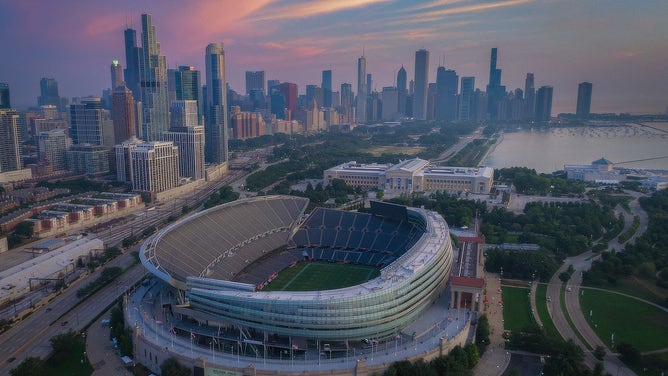How different will the weather be for the Chicago Bears' move to Arlington Heights?
If you are a Chicago Bears fan, you were probably surprised by the news of the organization signing a purchase agreement for the Arlington International Racecourse Tuesday. If you are a Green Bay Packers fan, you are probably laughing, knowing that a new field won't help the team's offense.
Without getting into the quarterback or coaching situation, how different will the weather be now that the stadium will soon be moved, and will that help the Bears?
Soldier Field, where the Bears currently play, is located next to Lake Michigan in downtown Chicago, near the southwest corner of the lake on Lake Shore Drive.
CHICAGO, ILLINOIS - AUGUST 21: In an aerial view, Soldier Field is seen before a pre-season game between the Chicago Bears and the Buffalo Bills at Soldier Field on August 21, 2021 in Chicago, Illinois. (Photo by Quinn Harris/Getty Images)
(Getty Images)
The Arlington Racetrack is about 30 miles from Soldier Field, just northwest of O'Hare International Airport, in Arlington Heights.
Even though the two venues are only about 30 miles apart, the difference in weather is noticeable. Other than the obvious sunshine and a nice cold beer, the weather at Soldier Field has many variables that impact it and what it actually feels like.
Lake Michigan plays a significant role.
Without getting into the science of hydrogen bonds between water molecules, water has a high heat capacity. A large body of water will heat and cool much more slowly than land. Because water is fluid, it allows heat to be mixed more than on land, making land temperatures near a body of water more moderate. The higher heat capacity of water keeps temperatures within a narrow range. Temperatures not near water tend to have a much wider range of seasonal temperatures.

Current water temperature - Generated Sept. 29, 2021
(NOAA/GLERL)
Currently, the warmest part of Lake Michigan is 68 degrees. As the football season progresses, temperatures of the lake will drop around 8-10 degrees per month until January, where it'll sit just at or above freezing for the rest of the season.
That warmer water also helps to enhance lake effect snow. While Arlington Heights certainly has a chance for a lake effect snow band to reach the city, the location of Soldier Field has a greater chance to receive those enhanced snow bands.
Soldier Field has a greater fetch (no, not the game you play with your dog or the famous "Mean Girls" term). Fetch is defined as the distance the wind travels over the open water—the greater the fetch, the better potential for lake effect snow. Because Chicago tends to get northerly winds in the fall and winter, that air will travel almost the entire length of Lake Michigan before it hits Soldier Field.
For Arlington Heights to see a lake effect snow band, there would need to be an easterly wind, but the distance for that wind to travel will be much shorter. Because of this, the racetrack has a much lower probability of seeing a lake effect band than Soldier Field.
Urban Heat Island Effect
Chicago is usually warmer than the suburbs because of the urban heat island effect.
A heat island is where urban areas experience higher temperatures than outlying areas because of large structures like skyscrapers. These buildings absorb and re-emit the sun's heat. The island part of this term refers to the highly concentrated areas of these large buildings.
Generally, daytime temperatures of these heat islands record about 1-7 degrees higher than those outlying areas like the Arlington Racetrack.
Isn't the ‘Windy City’ windier?
Even though Chicago is named the ‘Windy City,’ it is actually not because of how much wind it receives.
The history of that name is said to come from a New York newspaper article rather than gusty winds. The editorial called Chicago a "windy city" due to the city's politicians who were full of hot air after vying for an exposition to be held in Chicago rather than New York.
If you are downtown Chicago, it can certainly feel windier. This situation is likely due to wind traveling quicker through those large buildings, known as the wind tunnel effect. This effect happens between two large buildings. The closer the buildings are, the faster the wind will travel through those buildings.
Wind speeds also differ from land to near water. Due to the friction on land (think trees, houses, etc.), the wind is slower over land than water. Because Soldier Field is next to Lake Michigan, you may feel more of a gustier onshore breeze while tailgating.
More accurate weather readings near the racetrack
While Chicago meteorologists are some of the best in the country, the location of the Arlington Racetrack has more accurate readings simply because it is closer to O'Hare Airport.
O'Hare International Airport is less than ten miles south of the racetrack. The airport staffs meteorologists and weather observers and has a long history of records for that specific location. Pinpoint forecasting is easier for locations near the airport than those along the lakeshore.
But what about a roof?
Soldier Field does not currently have a roof and can receive whatever type of weather that Mother Nature serves up on game day.
As a meteorologist, I urge the Bears organization to put a roof on the racetrack. While playing in a snow-filled game may be fun to watch, I doubt the players want to worry about the slickness of the ball when passing and receiving.
Plus, you will not have to worry about any of the previously listed weather impacts within the stadium with a roof. If they are truly investing in the new land and signed $197.2 million away, I think they can chip in a few more dollars to buy a roof to mitigate weather effects. After all, the Bears need all the help they can get.
